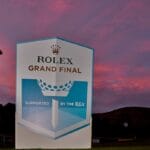Pádraig Harrington and Sam Torrance shared a common bond of love and respect for the late Bob Torrance, father of Sam and coach of Harrington for over a decade.
Torrance junior learned his golf from his dad, who was a hard taskmaster, but who gave his son the skills to forge a successful career as a professional golfer. Harrington’s ambition led him to seek assistance from Bob Torrance in 1998, and from then until they parted company in 2011, the elderly Scot had a significant role in the Dubliner’s rise to greatness as a three-time Major champion.
Sam and Pádraig were both born in late August – Torrance on August 23, 1953, and Harrington on August 31, 1971.
Yes, they are from different generations and many years separate them, but the Scotsman and the Irishman have a number of other connections. Both are Irish Open champions – Torrance at Portmarnock (1981) and Mount Juliet (1995) – Harrington at Adare Manor in 2007.
They have each represented Europe as players in the Ryder Cup, experiencing all the highs and lows of these biennial clashes with the USA.
Torrance’s stretch ran from 1981 to 1995. He played on the winning side in 1985 and 1987, the former at The Belfry when he holed the winning putt for a first victory under the European banner, and the latter a first win on US soil.
Two years later Torrance helped Europe retain the trophy with a halved match at The Belfry, effectively a hat-trick for the home side.
Harrington earned a place on the team six times from 1999-2010 inclusive.
His debut was a torrid affair at Brookline in 1999 when Ben Crenshaw’s men staged a final day comeback to claim the trophy.
The Dubliner went on to savour the joy of victory in 2002 under Torrance’s captaincy, and enjoyed further success in 2004, 2006, and 2010. In that period, the only blot on the landscape was the 2008 defeat to the USA at Valhalla.
Torrance and Harrington have served the European cause as vice-captains in recent years and, of course, the Scot proved himself an adroit and eminently capable captain in 2002.
Harrington was delighted to accept the captaincy role for 2020, but there’s the nub of it: if this Covid-19 calamity does not get resolved sooner than later, it could be that Harrington will share Torrance’s fate of being a European captain with no match to play in the scheduled year.
The circumstances are different, but a postponement could yet happen.
Back in 2001, the Ryder Cup was to be played at The Belfry from September 28-30 until the horror of the 9/11 terrorist attacks devastated America and the civilised world.
By September 16, the Ryder Cup conversation was over. The PGA of America issued a statement saying that the scope of the tragedy was so overwhelming that it would be impossible for the United States Ryder Cup team and officials to attend the matches that month.
There was no disagreement on the European side. Torrance said the postponement decision was “common sense.”
“I am desperately heartbroken for all the people involved in this terrible tragedy,” he said.
Both sides agreed that the selected captains and teams would reconvene at the appointed venue, The Belfry, 12 months later.
The match duly took place in September 2002, albeit under heavy security, and Torrance’s team triumphed with Paul McGinley becoming a Ryder Cup hero by holing the winning putt.
This time we have a slow burner. The pandemic is in full flow across the globe. Unlike 2001, which was a sudden, sharp shock internationally, we in Ireland are in lockdown as are other countries, with businesses and industry closed and no restart date in sight.
Even in World War 2, the citizens on both sides were able, and indeed obliged in many cases, to go about their normal business despite the mutual bombing and destruction.
In Britain, soccer matches and golf exhibitions were played during the War years to boost morale and large crowds took advantage of the brief interludes from wartime misery.
Now, in 2020, people can be arrested for breaking the law on gathering in numbers, and checkpoints are set up to ascertain reasons for being out on the roads.
We have experienced in just a couple of weeks, a shuddering halt to normal life and freedoms.
Grotesque. Unbelievable. Bizarre. Unprecedented.
Pádraig Harrington and his US Ryder Cup counterpart Steve Stricker appreciate that golf, like all sports, has to stand aside while the virus crisis continues, but they are optimistic that time favours the likelihood of the event going ahead at Whistling Straits as planned from September 25-27.
Let’s hope they’re right, because if that happens, it will mean that normal commerce and travel and business is back on the agenda.
And before the keyboard warriors rush to decry discussion of Ryder Cups and golf as irrelevant in these times, let’s pause and realise that golf, ranging from Tour events to the humble club player is a massive industry and source of employment in Ireland and worldwide.
Golf tourism has a €270 million benefit and overall, the sport is worth around €540 million to our economy.
An Irishman leading Europe into battle with the USA next September would be a huge boost to restoring confidence that we are on the long road back to normality.
























Leave a comment